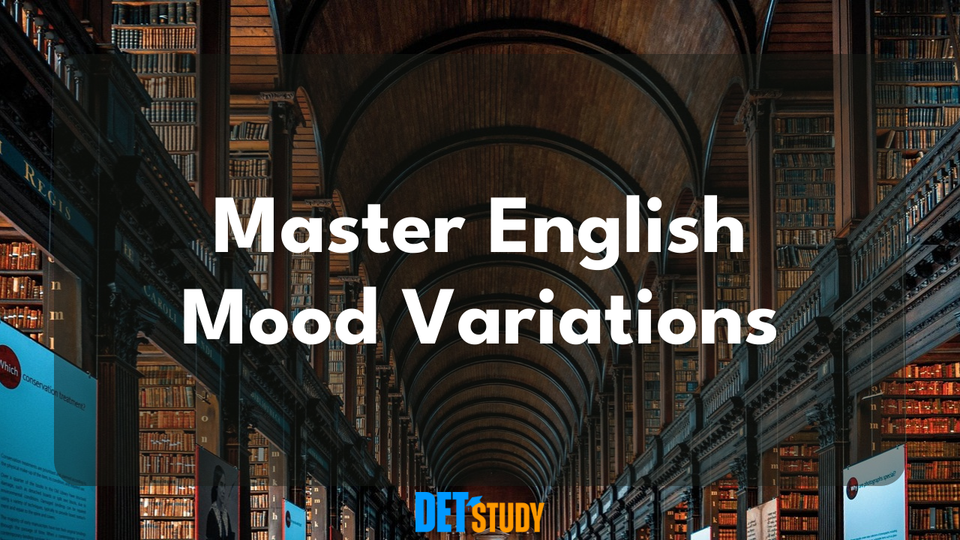Indicative Imperative Subjunctive: Master English Mood Variations for Fluent Communication

Understanding the English Verb Moods: Indicative, Imperative, and Subjunctive
Understanding verb moods is essential for English language learners, as they express different intentions of the speaker or writer. Let’s break down the three primary moods in English: indicative, imperative, and subjunctive.
Duolingo English Test vs. TOEFL: Which One Is Better for You?Indicative Mood
The indicative mood is used to make factual statements, ask questions, or express opinions based on reality. It's the most common verb mood in English.
Examples: - Statement of Fact: "She goes to school every day." - Opinion: "I think he is the best candidate for the job." - Question: "Do you know where the library is?"
The indicative mood is straightforward as it deals with facts and actual events.
Imperative Mood
The imperative mood is used to issue commands, requests, or instructions. It often has an implied subject—you, which is generally left out.
Examples: - Command: "Close the door." - Request: "Please pass the salt." - Instruction: "Follow the signs to the nearest exit."
Note how the verbs appear at the beginning of the sentence, emphasizing action.
Subjunctive Mood
The subjunctive mood expresses wishes, hypothetical situations, demands, or suggestions. It differs from the indicative because it’s not about stating facts but rather about possibilities or desires. The subjunctive can be tricky as it often seems similar to other moods.
For forming the subjunctive mood: - Use the base form of the verb, even for singular subjects. - Use "were" instead of "was" for hypothetical or wishful situations.
Examples: - Wish: "I wish that he were here." - Hypothetical Situation: "If I were rich, I would travel the world." - Suggestion: "It is essential that she speak with the manager."
Key words like "wish," "if," and phrases like "it is essential that" often introduce the subjunctive mood.
Understanding these moods helps in correctly conveying the intended meaning and nuance in English. By identifying the mood of verbs, learners can refine their communication and grasp subtle differences in intent.
The Indicative Mood: Expressing Statements of Fact
The indicative mood is the most commonly used verb mood in English, predominantly employed to express facts, beliefs, and questions grounded in reality. It's the go-to mood for describing actual events or conveying information that is considered true.
Statements of Fact
In the indicative mood, sentences often convey information about the present, past, or future. Here are some examples:
- Present Fact: "The Earth orbits the Sun."
- Past Fact: "The Romans built impressive structures."
- Future Fact: "The conference will begin at 9 AM tomorrow."
These examples demonstrate how the indicative mood forms the backbone of factual communication in English.
Asking Questions
When forming questions, the indicative mood is used to seek factual information. It helps clarify details or confirm assumptions:
- Simple Question: "Is she coming to the party?"
- Detailed Inquiry: "What time does the train leave?"
These questions expect responses that are based on actual data or knowledge.
Expressing Opinions
While primarily associated with facts, the indicative mood can also express opinions, particularly when the speaker treats the opinion as a fact. Notice the subtle difference:
- Opinion as Fact: "In my opinion, this is the best movie of the year."
- Personal Belief: "She thinks that her team is the strongest contender."
In these sentences, opinions are conveyed with the same certainty as statements of fact, even though they are subjective.
Describing Conditions and Events
The indicative mood also describes conditions and events, stating how things are or were:
- Condition: "The sky is clear."
- Event: "He won the race last Saturday."
These types of sentences illustrate situations or actions as they exist in reality.
Free Test QuestionsKey Features of the Indicative Mood
- Common Verbs: Most verbs in indicative sentences don't require any special conjugation or form, aside from the usual subject-verb agreement (e.g., "she walks," "they walk").
- Flexible Tense Use: The indicative mood can be used in all tenses, allowing for a range of expression about different times and realities.
Mastering the indicative mood is essential for clear communication in English since it forms the basis for exchanging factual information. Understanding and using it effectively allows learners to convey their thoughts and inquiries accurately.
The Imperative Mood: Giving Commands and Requests
The imperative mood is primarily used to issue commands, make requests, or offer invitations. It is direct and often used when you want someone to do something. Unlike the indicative and subjunctive moods, the imperative mood typically does not require a subject, as it is usually understood to be "you."
Forming the Imperative
To form the imperative, use the base form of the verb. Here are some examples:
- Command: "Sit down."
- Request: "Please pass the salt."
- Invitation: "Join us for lunch."
Key Features of the Imperative Mood
- Simplicity: The imperative mood is straightforward, using just the base form of the verb without additional endings.
Example: - "Close the door."
- Politeness Indicators: While commands can be blunt, you can add politeness by including words like "please" or using softer phrasing.
Example: - "Please, take a seat." - "Could you open the window?"
- Negative Commands: To tell someone not to do something, use "do not" or the contraction "don't" followed by the base form of the verb.
Examples: - "Do not touch the stove." - "Don't forget your keys."
- First-Person Plural: The imperative can also be inclusive, using "let's" to suggest actions that the speaker will join in.
Example: - "Let's go for a walk." - "Let's start the meeting."
- Emphasis on Urgency: Commands can express urgency or necessity, emphasizing that an action must be taken immediately.
Example: - "Hurry up!" - "Call a doctor!"

Common Uses in Daily Life
The imperative mood is pervasive in everyday interactions, signage, and instructions. Here are some familiar contexts:
- In Instructions: "Mix the ingredients well."
- On Signs: "Stop," "Yield," or "No Parking."
- In Requests: "Email me your feedback by the end of the day."
Understanding the imperative mood enables you to give clear directions and make polite requests effectively, which is crucial for daily communication and interaction.
The Subjunctive Mood: Exploring Hypotheticals and Wishes
The subjunctive mood in English is less frequently used than the indicative or imperative moods but plays a vital role in expressing wishes, hypotheticals, demands, suggestions, or conditions contrary to fact. It often appears in subordinate clauses and is more common in formal writing and speech.
Expressing Wishes and Desires
The subjunctive mood is typically used after verbs that express a wish, desire, or hope.
- Example:
- "I wish that he were here."
- "She wishes she were taller."
Notice the use of "were" instead of the indicative "was," which is a hallmark of the subjunctive mood when referring to hypothetical situations or wishes.
Hypothetical Situations
When dealing with situations that are contrary to reality, the past subjunctive form is often used.
- Example:
- "If I were a millionaire, I would travel the world."
- "If she were in charge, things would be different."
Here again, "were" indicates a situation that isn't true or is imagined.
Save Money on Your Duolingo English Test with Official Coupon CodeMaking Demands or Suggestions
The present subjunctive is used after certain verbs and expressions to express a necessity, demand, or strong suggestion.
- Examples:
- "I suggest that he speak to her."
- "It is essential that she be informed."
- "The teacher insists that everyone arrive on time."
Notice how the verb "speak" and "be" are in their base form, regardless of the subject.
Using "If" Clauses
The subjunctive is often found in conditional sentences using "if" to suggest that the action is not real or is contingent.
- Examples:
- "If it were up to me, I would change the policy."
- "If he were taller, he could play basketball more effectively."
Expressions and Idiomatic Phrases
Some fixed expressions in English traditionally use the subjunctive.
- Examples:
- "God save the Queen."
- "Heaven help us."
- "So be it."
Verbs and Adjectives That Trigger the Subjunctive
Set phrases often accompany particular verbs and adjectives that require the subjunctive mood:
- Example Verbs: recommend, suggest, insist, demand, require
-
"They recommend that she attend the meeting."
-
Example Adjectives: important, crucial, necessary, essential
- "It is crucial that each member contribute."
The subjunctive mood, though sometimes subtle, enriches English by allowing speakers to discuss non-real, desired, or demanded states and actions, extending the language’s ability to convey complex emotions and scenarios.
Start DET PracticeComparing the Moods: Recognizing and Using Them Effectively
In English, verbs convey different meanings through various moods: the indicative, imperative, and subjunctive. Each mood serves a distinct purpose and understanding their differences can greatly enhance your language skills.
Indicative Mood
The indicative mood is the most common and is used to make factual statements or ask questions. It describes reality and states what is actually happening.
Examples:
- "She walks to school every day."
- "Do they understand the instructions?"
- "He is reading a book."
In these examples, the sentences convey straightforward facts or questions.
Imperative Mood
The imperative is used for commands, requests, or instructions. This mood typically uses the base form of the verb and often assumes an implied subject, usually "you."
Examples:
- "Close the door."
- "Please sit down."
- "Don’t forget your keys."
The imperative mood is direct and is often used in everyday interactions to give orders or make polite requests.
Subjunctive Mood
As discussed in earlier sections, the subjunctive mood expresses wishes, hypothetical situations, demands, or suggestions. It often appears in clauses beginning with "if" or following certain verbs and adjectives.
Remember that in the subjunctive mood, verbs may not change according to the subject and often use the base form.
Examples Revisited:
- "If I were you, I’d apologize."
- "The committee requests that she be present."
- "It’s vital that he take the medicine."
By distinguishing between the indicative, imperative, and subjunctive moods, you can tailor your sentences to accurately reflect your intentions, whether describing reality, issuing commands, or discussing hypotheticals. Each mood plays a crucial role in effective communication and mastering their usage is a step towards advanced English proficiency.
DET Study provides an extensive suite of over 15,000 practice questions, focusing on leveraging adjectives and adverbs to fortify your grammatical skills. Regular practice with these targeted materials ensures that you approach the Duolingo English Test with enhanced confidence and precision, ready to achieve your desired scores.
🎯 Need more practice? Check out DETStudy.com for expert resources, 15,000+ practice questions, and AI-powered writing and speaking feedback.
Frequently Asked Questions (FAQ)
What is the indicative mood in English?
What is the imperative mood in English?
What is the subjunctive mood in English?

